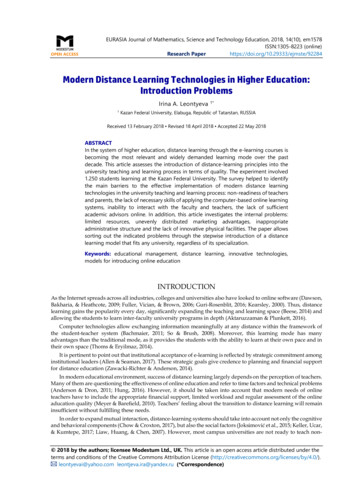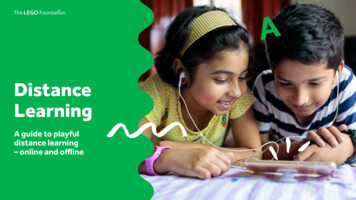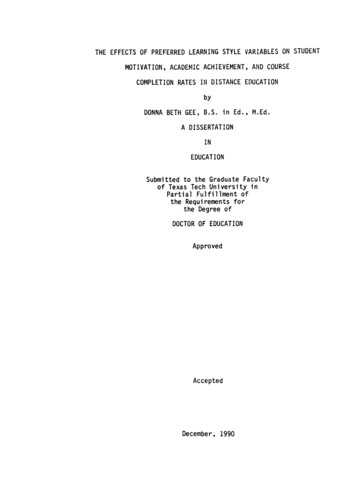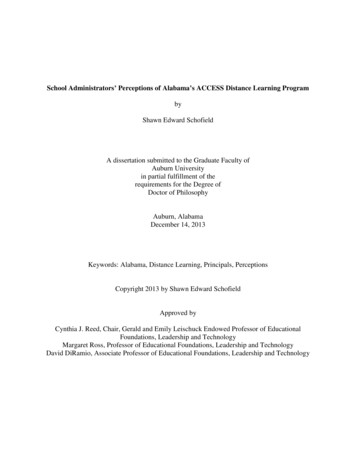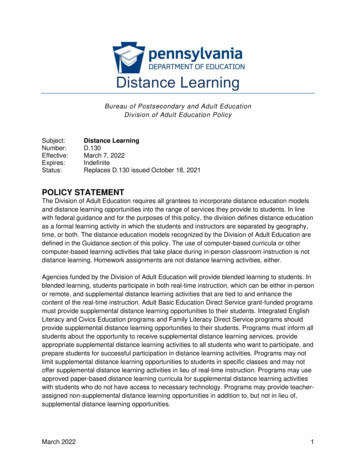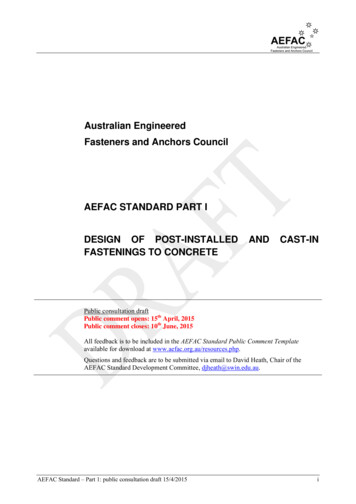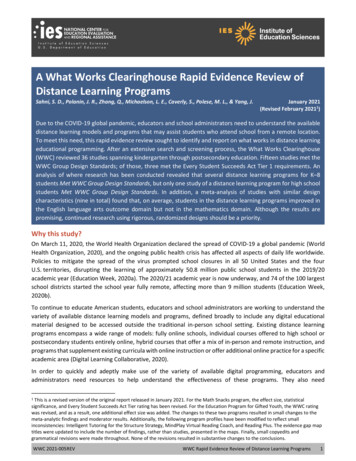
Transcription
EurasiaJournal of Mathematics, Science&TechnologyEducation, 2014, 10(6), 575-580Effects of Distance Learning onLearning EffectivenessHong-Cheng LiuI-Shou University, TAIWANJih-Rong YenNational Pingtung University of Education, TAIWANReceived 16 March 2014; accepted 15 October 2014The development of computers in the past two decades has resulted in the changes ofeducation in enterprises and schools. The advance of computer hardware and platformsallow colleges generally applying distance courses to instruction that both Ministry ofEducation and colleges have paid attention to the development of Distance Learning. Toimprove the quality of distance learning and students’ learning effectiveness in theinvestigated universities, quantitative survey with SPSS19.0 is applied to analyzing data inthis study, in which Factor Analysis, Reliability Analysis, Regression Analysis, and Analysisof Variance are utilized for organizing and analyzing data. About 600 college students inDepartment of Public Administration are proceeded questionnaire survey, and 472 validcopies are studied. The research findings show that 1.Distance Learning appearssignificantly positive effects on Curriculum Instruction in Learning Effectiveness;2.Distance Learning presents notably positive effects on Technological Media in LearningEffectiveness; 3.Distance learning reveals remarkably positive effects on CurriculumManagement in Learning Effectiveness; and, 4.demographic variables appear notableeffects on the correlations between Distance Learning and Learning Effectiveness.Keywords: Distance Learning, Learning Effectiveness, Public Administration.INTRODUCTIONIn such an era when information is rapidly developing,the Internet presents the characteristics of instantaneity,not being restricted in solid space of classrooms, andconvenience for two-way interaction. When computerbased information is included in instruction, students’learning interests could possibly be enhanced. DistanceLearning, with various versions, is also named digitallearning. In 1990s, the rapid development of networkand the general applications of computers and networkCorrespondence to: Hong-Cheng Liu,Assistance Professor of Department of PublicPolicy and Management, I-Shou University, No.1Sec. 1, Syuecheng Rd., Dashu District, KaohsiungCity 840 Taiwan, ROC.Email: hcliu@isu.edu.twdoi: 10.12973/eurasia.2014.1218ahave learning break through the restriction of regions,and synchronous and asynchronous distance learning isused for achieving the learning effect. Distance courseshave been commonly applied to the instruction incolleges. Distance learning therefore has become acritical channel between school instruction and studentlearning. Some information experts predict that printingwill no longer be the mainstream, but audio/videocontents would be the major propagation.In such an information society, information literacyand the application capability are the essentialintelligence for modern people; and, the applications ofinformation technology to enhancing nationalcompetitiveness have been the common objective ofadvanced countries. Accordingly, information educationis regarded as the foundation stone for a nation and anindividual toward information era. Since the era ofknowledge economy, the Internet, instead of traditionalsubjects, has become a critical and potential element inPublic Administration. The explosive development ofCopyright 2014 by iSER, InternationalSociety of EducationalResearchISSN: 1305-8223
H.-C. Liu & J.-R. YenState of the literature The study aims to develop a scale instrument toallow us to determine the self-efficacy perceptionsof primary education teachers regarding their use oftechnology when educating students. The developed scale instrument was obtained in thewake of the data gathered from primary educationteachers. According to the conducted analyses of thedeveloped scale instrument, it was determined tohave validity and reliability.Contribution of this paper to the literature The developed scale instrument is going tocontribute to the literature in that it will make theinformation technologies coherent with theeducation, thus creating a model for nt. That the developed scale instrument on informationtechnologies included numerous expressions aboutdifferent aspects is vital in terms of it beingintended for the use of all education instruments. It is thought that the scale instrument puts forth theself-efficacy perceptions regarding the use ofinformation technologies from the point of view ofbasic skills and the anxiety state.the Internet and e-commerce in the past two years hasresearchers, practical managers, and the public witnessthe fact and potential of 3C1 technology changing thesocial style, commercial behaviors, organizationalmanagement, and political operation. It is undeniablethat the Internet would be a key power leading thepublic organization. In such an information era, PublicAdministration belongs to the fiercely competitivemanagement that most researchers regard DistanceLearning and digital communication ability as the basiccompetence of public administrators. Apparently,Distance Learning is getting important in PublicAdministration.According to the international concerns aboutDistance Learning, it is found from the development ofgeneral distance curriculum in domestic colleges and thecertification of distance curriculum and materials thatthe development of Distance Learning has beenextremely emphasized in the world, Ministry ofEducation, and colleges. The development of domesticDistance Learning has shown certain scale that theeffects of Distance Learning on schools and studentsare considerable. As a result, Distance Learning deservesthe emphasis of researchers.576LITERATURE REVIEWDistance LearningDistance Education, originated in mid-18th century,aimed to compensate the insufficiency of traditionaleducation. It rapidly developed from correspondencecourses and tapes (Williams, Paprock& Covington,1999) to the release of personal computers and theapplications of computer-based multimedia applications.The maturity of network technology has computerbased network technology become the advantageousmedia in current Distance Education, which providesmore flexibilities and learning opportunities (Huang etal., 2009; Yin et al., 2010). The emphasis of LifelongLearning has challenged the traditional ideas of schoolsbeing the final learning places. The broad applicationsof the Internet have Distance Education becomeanother wave of learning mainstream (Tsou, 2009).Web-based instruction is open-ended, in which theresources are almost endless and infinite. Learners couldreceive resources of texts, figures, audio and video, andinterpersonal interaction through hyperlinks and onlineinquiries (Chen, 2010).Distance Learning used to be confused withDistance Education and Distance Instruction. As amatter of fact, Distance Learning stresses on students’learning processes in Distance Learning that it isstudent-centered (Huang et al., 2009). Distance Learningwas described, in American Education Conference in1996, as a system or process connecting the classifiedlearning resources and learners (Lewis, 2000). Williams,Paprock& Covington (1999) regarded DistanceLearning or Distance Education as learning allocation –the instruction presented when learners and teacherswere separated in space and time. Billings et al. (2001)described Distance Learning as the segmentedtime/space between learners and teachers thateducation technology was utilized for establishing alearning environment for the continuous education ofnursing staff.Distance Learning could be segmented by time andspace and generally presented by synchronous andasynchronous (Billingset al., 2001; Lewis, 2000).Synchronous activities refer to several peoplesimultaneously communicating on the computer-basednetwork, such as videoconferencing, with which theusers could see images and hear voice at the same time.Asynchronous activities indicate the communicationamong several people not at the same time that theinformation is stored in a designated computer, whichtheoretically could be read, seen, or heard by the users atany time and places (Chiu, 2009). In adult education,autonomous and flexible learning is emphasized. Theasynchronous learning approach offered in computerbased network technology features the flexibility of 2014 iSER, Eurasia J. Math. Sci. &Tech. Ed., 10(6), 575-580
Distance Learninglearning time that learners could precede individual andcollaborative learning (Lu, 2009). It is estimated thatasynchronous computer-based network learning wouldbecome the mainstream in the future. For nursing staffin public health, asynchronous distance learning wouldbe suitable for the work characters and the restrictionsof family responsibilities (Cragg, 1994) that it isconsidered as the best approach for on-job training(Farel&Polhamus, 2001; Yin, 2009; Chiu & Wu, 2010).Simonson et al. (2000) pointed out learners as the keymembers in Distance Learning and Attitude,Experience, Cognition, and Learning Styles being theprimary indices to measure Distance Learning, in whichAttitude was regarded as the most important index.Attitude is considered as a lasting and consistentpsychological response to people, affairs, and objects.The questionnaire of Distance Learning Effectiveness inthis study therefore refers to the research dimensionsproposed by Simonson et al. (2000)Learning EffectivenessLearning Effectiveness refers to the learner’slearning results in formative and summativeevaluations.Gilliver, Randall &Pok (1998) discussed theeffects of online courses on learning and found higherLearning Effectiveness of the experiment group withweb-based learning.Shiratuddin (2001) studied 169college students with lecturing and online learning andalso discovered the higher Learning Effectiveness of theonline learning group.However, Freeman, Grimes &Holliday (2000) found no distinct effect of distanceaudio/video and two traditional instruction on LearningEffectiveness. It was discovered that team learningappeared higher Learning Effectiveness than individuallearning did on computer-based curriculum; besides,team learning presented significant promotion onLearning Effectiveness of low-achievement students.Uribe et al. (1995) proved the higher LearningEffectiveness of the matched group than the individualgroup. However, Klein & Doran (1999) concludeddifferent findings that, in the computer-based course,no remarkable difference in Learning Effectivenessamong the individual, the extended interactive, and therandom interactive groups. There are a lot of factors inLearning Effectiveness. Wang (2009) indicated thatlearners preferring abstract concepts, in passivelyobserved learners, appeared higher LearningEffectiveness.Chien (2009) noticed the notabledifferences between Learning Styles and LearningEffectiveness, but the effects of Learning Styles onLearning Effectiveness became insignificant after theuse of multimedia-assisted materials. In this case,interactive multimedia–assisted materials could reducethe effects of Learning Styles on Learning Effectiveness.In other words, interactive multimedia-assisted materials 2014 iSER, Eurasia J. Math. Sci. &Tech. Ed.,10(6), 575-580could adapt to learners with different learning styles andreduce the effects of Learning Styles.Regarding Learning Effectiveness, Biner (1993)explored the evaluation tools for Learning Attitude inDistance Educationandfound the key dimensions ofCurriculum Instruction, Technological Media, andCurriculum Management. This study therefore refers tothe research dimensions of Biner (1993) for thequestionnaire of Distance Learning Effectiveness.RESEARCH METHODResearch hypothesis deductionUribe et al. (1995) pointed out the factors inLearning Effectiveness as personal characters ent. Hsu (2010) regarded the factors intraining effectiveness as personal characters (includinggender, age, education background, class, and ude,Expectation, and Opinion of training contents), andenvironmental factors (covering organizational climate,work environment, and supervisor and peer support).With the integration of above literatures, the factors inLearning Effectiveness generally contain demographicvariables (like age, education background, gender,seniority) and learning factors in education psychology(such as individual personality trait, self-efficacy,learning participation, learning satisfaction, learningability, learning motivation, learning style, learningapproach, learning cognition, learning attitude, responseto learning content).Learning Effectiveness, as an index to measurelearners’ learning results (Wang, 2009), is one of the keyitems in instruction quality evaluation. LearningEffectiveness would be affected by learning styles,curriculum design, and instruction (Kearsley, 2009) thata lot of researchers invest in discussing the effects ofpersonal characters or learning behaviors on LearningEffectiveness. For instance, Lynch et al. (1998) exploredthe effects of Learning Styles on Learning Effectivenessof students in medical schools and the relationship; and,Jones (1996) discovered the partial effects of ability,self-efficacy, and individual objective on effectiveness.Apparently, there are plenty of factors in LearningEffectiveness. Aiming at some factors in LearningEffectiveness, the effects of Distance Learning onLearning Effectiveness are investigated in this study.The following hypotheses are further proposed.H1: Distance Learning shows notably positiveeffects on Curriculum Instruction in LearningEffectiveness.H2: Distance Learning presents remarkably positiveeffects on Technological Media in LearningEffectiveness.577
H.-C. Liu & J.-R. YenFigure 1. Research FrameH3: Distance Learning reveals significantly positiveeffects on Curriculum Management in LearningEffectiveness.H4: Gender appears remarkable effects on thecorrelations between Distance Learning and LearningEffectiveness.H5: Age shows significant effects on the correlationsbetween Distance Learning and Learning Effectiveness.H6: Class reveals notable effects on the correlationsbetween Distance Learning and Learning Effectiveness.Research frameworkAccording to domestic and international research,the research framework is proposed to discuss thecorrelations between Distance Learning and LearningEffectiveness.Research subjects and samplingBased on top ten universities in Department ofPublic Administration in Taiwan, including NationalTaiwan University, National Chengchi University,National Taipei University, National Chi NanUniversity, National University of Tainan, TaipeiMunicipal University of Education, TamkangUniversity, Shih Hsin University, Chinese CultureUniversity, and Tunghai University, the students inDepartment of Public Administration are selected forthe questionnaire survey. With convenient sampling,total 600 copies are distributed, and 472 valid ones areretrieved, with the retrieval rate 79%.ANALYSIS AND DISCUSSIONFactor analysis of distance learningWith Factor Analysis, four factors were extractedfrom Distance Learning Scale, including Attitude(eigenvalue 3.131,α 0.83),Experience(eigenvalue 2.683,α 0.81),Cognition(eigenvalue 2.162, α 0.88), and Learning Styles(eigenvalue 1.527, α 0.86). The co-variance explainedachieved 77.945%.578With Factor Analysis three factors were extractedfrom Learning Effectiveness Scale, containingCurriculum Instruction (eigenvalue 2.419, α 0.87),Technological Media (eigenvalue 1.897, α 0.80), andCurriculum Management (eigenvalue 1.335, α 0.84).The co-variance explained reached 72.684%.Correlation analysis between distance learningand curriculum instruction in learning effectivenessApplying Regression Analysis to testing H1, Table 1,the regression equation achieved the significance(F 16.884, p 0.000). Distance Learning appearedsignificant effects on Curriculum Instruction, whereAttitude and Learning Styles showed remarkablypositive effects on Curriculum Instruction and achievedthe significance (β 0.196*, β 0.173*). H1 wastherefore partially supported.Correlation analysis between distance learningand technological media in learning effectivenessApplying Regression Analysis to testing H2, Table 1,the regression equation reached the significance(F 19.435, p 0.000). Distance Learning showednotable effects on Technological Media, whereExperience, Cognition, and Learning Styles presentedremarkably positive effects on Technological Media andachieved the significance (β 0.153*, β 0.212**, β 0.182*) that H2 was partially supported.Correlation analysis between distance learningand curriculum management in learningeffectivenessApplying Regression Analysis to testing H3, Table 1,the regression equation achieved the significance(F 25.362, p 0.000). Distance Learning nagement, where Experience, Cognition, andLearning Styles showed remarkable effects onCurriculum Management and reached the significance (β 0.167*, β 0.158*, β 0.179*). H3 was thereforepartially supported. 2014 iSER, Eurasia J. Math. Sci. &Tech. Ed., 10(6), 575-580
Distance LearningTable 1. Regression analysis between distance learning and curriculum management in learning effectivenessLearning Effectiveness (dependent variable)TechnologicalCurriculum InstructionCurriculum ManagementMediaDistance Learning (independent 153*0.167*Cognition0.1030.212**0.158*Learning lated R20.0330.0460.051*p 0.05 **p 0.01 ***p 0.001Note: * stands for p 0.05, ** for p 0.01.Table 2. Effects of demographic variables on the correlations between distance learning and learning effectivenessDemographicCurriculumDistance Learning Curriculum Instruction Technological antNot significantExperienceNot significantSignificantNot significantGenderCognitionNot significantNot significantSignificantLearning StylesSignificantNot ntNot significantExperienceSignificantNot significantSignificantAgeCognitionNot significantSignificantNot significantLearning StylesSignificantNot significantSignificantAttitudeNot significantNot cantNot significantClassCognitionNot significantSignificantNot significantLearning StylesSignificantNot significantNot significantData source: self-organized in this studyModerating effects of demographic variableExperience, Learning Styles and CurriculumManagement that H5 was partially supported.Effects of gender on the correlations betweenDistance Learning and Learning EffectivenessEffects of class on the correlations betweenDistance Learning and Learning EffectivenessWith Analysis of Variance, the empirical results,Table 2, presented the notable effects of gender on thecorrelations between Attitude, Learning Styles andCurriculum Instruction, between Attitude, Experienceand Technological Media, and between Cognition,Learning Styles and Curriculum Management that H4was partially supported.With Analysis of Variance, the empirical results,Table 2, presented the remarkable effects of class on thecorrelations between Experience, Learning Styles andCurriculum Instruction, between Experience, Cognitionand Technological Media, and between Attitude andCurriculum Management that H6 was partiallysupported.Effects of age on the correlations betweenDistance Learning and Learning EffectivenessCONCLUSIONWith Analysis of Variance, the empirical results,Table 2, revealed the notable effects of age on thecorrelations between Attitude, Experience, LearningStyles and Curriculum Instruction, between Attitude,Cognition and Technological Media, and between 2014 iSER, Eurasia J. Math. Sci. &Tech. Ed.,10(6), 575-580Summing up the data analyses and researchconclusions, the practical applications of DistanceLearning and the further research are proposedsuggestions. The research results present the effects ofAttitude, Experience, Cognition, and Learning Styles on579
H.-C. Liu & J.-R. YenLearning Effectiveness that Distance Learning appearsnotable effects on Learning Effectiveness.It is therefore suggested that proper schedule controlshould be included for students in Department ofPublic Administration cultivating regular reading habitsand autonomously controlling the time in DistanceLearning. The application of proper schedule control toguiding students learning step by step and enhancingtheir learning attitudes should be taken into accountwhen designing Technological Media and CurriculumManagement systems. In regard to CurriculumInstruction, students should present regular readinghabits and cultivate favorable learning attitudes andexperiences in Distance Learning so as to acquire theoptimal Learning Effectiveness. In the DistanceLearning process, fixed time for handing in assignmentscould have students appear continual learning attitudesand experiences. With the convenience of informationtechnology, the inclusion of multimedia interactivesystems could motivate students to interact throughvoice and images. As some students could not clearlyexpress the problems because of text key-in difficulty,certain extent of Chinese word key-in is required for theeffective application. It is therefore suggested toenhance the design of interactive systems so as toreinforce Learning Styles of students in Department ofPublic Administration and promote CurriculumInstruction and student participation.REFERENCESBillings, D. M., Ward, J. W., & Penton-Cooper, L. (2001).Distance Learning in Nursing. Seminars in OncologyNursing, 17(1), pp48-54.Biner, P. M. (1993). The development of an instrument tomeasure student attitudes toward televised courses. TheAmerican Journal of Distance Education. 7(1), 62-73.Chen, C.-W. (2010). Brief introduction of new instruction –network learning. Living Technology Education Journal,34(4), 10-16.Chien, T. N. (2009). Effects of interactive multimedia-assistedteaching materials on Learning Effectiveness ofcomputer-based instruction. Journal of Adult LifelongEducation, 12, 117-155.Chiu, C. H., Wu, H. M. (2010). Distance advanced studies forteachers. Information and Education, 77, 41-46.Chiu, G. F. (2009). Learning in network: Theory andDevelopment. Educational Research & Information, 6(1),20-27.Cragg, C. E. (1994). Nurses’ Experiences of a Post-RNCourse by Computer Mediated Conferencing: FriendlyUsers. Computers in Nursing, 12(5), 221-226.Farel, A. M., & Polhamus, B. (2001). Ensuring public healthprofessionals go the distance: A case study from anonline data skills course. Journal of Public HealthManagement and Practice, 7(3), 82-89.Freeman, M. W. ; Grimes, L. W. ; Holliday, J. R. (2000),Increasing Access to Learning With Hybrid Audio-Data580Collaboration, Educational Technology & Society, 3(3), 112121.Gilliver, R. S., Randall, B. and Pok, Y. M. (1998), Learning incyberspace: shaping the future. Journal of ComputerAssisted Learning, 14: 212–222.Hsu, C. C. (2010). A study on e-learning to the on jobtraining. Fu Jen Studies, 36, 101-120Huang, M. Y., Huang, C. S. (2009). Meaning, evolution, andthe theoretical analysis of Distance Education. AudioVisual Education Bimonthly, 40(4), 8-18.Jones, B.L.(1996), Self-Efficacy And Personal Goals InClassroom Performance: The Effect Of TaskExperience, A Dissertation Submitted to the Kent StateUniversity Graduate School of Management in partialfulfillment of the requirements for the degree of Doctorof Philosophy.Kearsley (2009), translated by Chao, Mei-sheng & Chen, Yaochen. Distance Education-The system. Taipei:Songkang.Klein, J. D., & Doran, M. S. (1999). Implementing individualand small group learning structures with a computersimulation. Educational Technology Research and Development,47 (1), 97–110.Lewis, J. M. (2000). Distance Education Foundation. In J.Novotny(Eds.), Distance Education in Nursing(pp.422). N.Y:Springer.Lu, P. Y. (2009). Application of web-based educationaltraining. Supercomputing World, 8(1), 46-52.Lynch G. T., Nancy N. W., Steele D. J., & Hanssen on Performance, The American Journal ofSurgery, 176, 62-66.Shiratuddin& Monica Landon (2001). Multiple intelligencebased E-books. Retrieved April02, 2012, /papers/Shiratuddin%20paper.pdfSimonson, M., Smaldino, S., Albright, M., &Zvacek, S. (1999).Teaching and Learning at a Distance-Foundations ofDistance Education. New Jersey:Upper Saddle River.Tsou, C. P.(2009). Welcome the network era of lifelonglearning. Information and Education, 66, 17-20.Uribe, J.P.,Braunstingl, R., Mujika, J., “A wall following robotwith a fuzzy logic controller optimized by a geneticalgorithm”, IEEE International Conference on FuzzySystems and The Second International FuzzyEngineering Symposium, Vol.5, pp. 77 – 82, 1995.Wang, T. B. (2009). Effects of training, computer selfefficacy, and Learning Styles on learning performance–fieldstudy of webpage design. Living Technology EducationJournal, 26(3), 45-57.Williams, M. L., Paprock, K., & Covington, B. (1999).Distance Learning-The Essential Guide. ThousandOaks, California: SAGE.Yin, C. H. (2009). Present situation of Ministry of Educationpromoting Distance Instruction and Lifelong Learning.Information and Education, 66, 2-8.Yin, M. C., Li, C. C. (2010). The theories and literature ofdistance education. Bulletin of Elementary Education, 10,21-80. 2014 iSER, Eurasia J. Math. Sci. &Tech. Ed., 10(6), 575-580
asynchronous computer-based network learning would become the mainstream in the future. For nursing staff in public health, asynchronous distance learning would be suitable for the work characters and the restrictions of family responsibilities (Cragg, 1994) that it is considered as the best approach for on-job training

